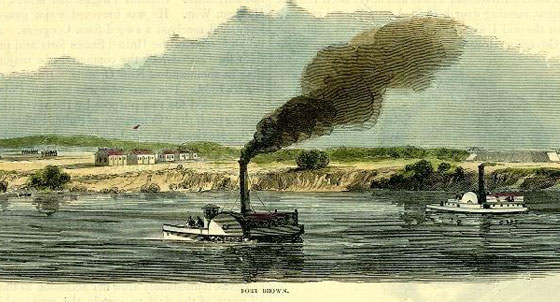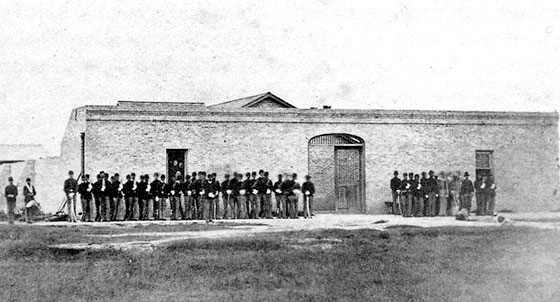Fort Brown
As the primary U.S. military establishment at the mouth of the Rio Grande, Fort Brown became a major prize for both sides during the Civil War. Originally named Fort Texas and later renamed in honor of Major Jacob Brown, one of the first casualties in the Mexican American War, the fort was built by General Zachary Taylor in 1846, making it the first major U.S. military post built along the Rio Grande. In February 1861, Union General David Twiggs—a southern sympathizer—agreed to surrender all military sites in Texas to the Confederacy. During most of the Civil War, Confederate troops at Fort Brown served as guardians of the prosperous cotton trade to Matamoros. In November 1863, however, General Napoleon Dana and seven thousand Union troops seized control of Brownsville. However, the Union army's presence there was brief as Union priorities shifted and troops were dispatched to other fronts. Confederate forces under Colonel John S. “Rip” Ford steadily pushed back the remaining Union troops. In July 1864 the Union once again abandoned the post, leaving Fort Brown in southern hands for the duration of the conflict. After May 1865, Fort Brown was re-occupied by the U.S. Army, including U.S. Colored Troops, and became the Rio Grande district headquarters, resuming its role as a guardian of the border. Fort Brown declined in importance as Mexico stabilized following its revolutionary period (1910-1917) and local law enforcement agencies replaced the military in policing the border. In September 1944 it was formally decommissioned when the 124th Cavalry was sent to Burma during World War II.
Listen
En su naturaleza de asentamiento militar principal de los EE.UU. en la desembocadura del Rio Grande, el Fuerte Brown se convirtió en un codiciado botín para ambos bandos durante la Guerra de Secesión. La fortificación fue construida por el General Zacarías Taylor en 1846 como el primer destacamento militar estadounidense levantado en las orillas del Río Grande, y fue denominado en sus principios «Fuerte Texas». Posteriormente fue rebautizado en honor del Mayor Jacob Brown, uno de los primeros fallecidos durante la Guerra Méxicoestadounidense o Guerra de Intervención. En febrero de 1861, el general unionista David Twiggs, simpatizante de la causa sureña, accedió a la rendición de todos los emplazamientos militares texanos a la Confederación, y durante la mayor parte de la Guerra de Secesión, las tropas confederadas ejercieron de salvaguarda para el próspero tráfico del algodón hacia la ciudad de Matamoros. En noviembre de 1863, no obstante, el General Napoleón Dana y un contingente de 7 000 soldados unionistas tomaron el control de Brownsville. Sin embargo, su presencia en el lugar fue breve, ya que un cambio de prioridades en las fuerzas de la Unión propició el desplazamiento de las tropas hacia otros frentes. Las fuerzas confederadas bajo el mando del Coronel John S. «Rip» Ford repelieron gradualmente el resto del contingente unionista que, en julio de 1864, abandonaba una vez más el acuartelamiento, dejando el Fuerte Brown en manos sureñas durante el resto de la contienda. Después de mayo de 1865, el fuerte fue tomado de nuevo por el Ejército de los Estados Unidos, incluyendo tropas del Regimiento Negro, y se convirtió en el cuartel general de la región del Río Grande, recuperando así su papel como guarda de la frontera. La importancia de Fort Brown menguó a medida que México se estabilizaba después de su ciclo revolucionario (1910-1917) y las agencias del orden público locales reemplazaron al ejército en la función del control fronterizo. En septiembre de 1944 fue decomisado de manera formal cuando el 124 de Caballería se desplegó en Birmania durante la Segunda Guerra Mundial.
Escucha
Details
Location: Off International Blvd. on the southern edge of Brownsville, TX, on the campus of the University of Texas at Brownsville/Texas Southmost College.
Access: The main campus where Fort Brown is located is accessible to visitors at all times, though visitor access to the interiors of the buildings may require university permission.
Contact: Call the university at 956-882-8200 for more information.


